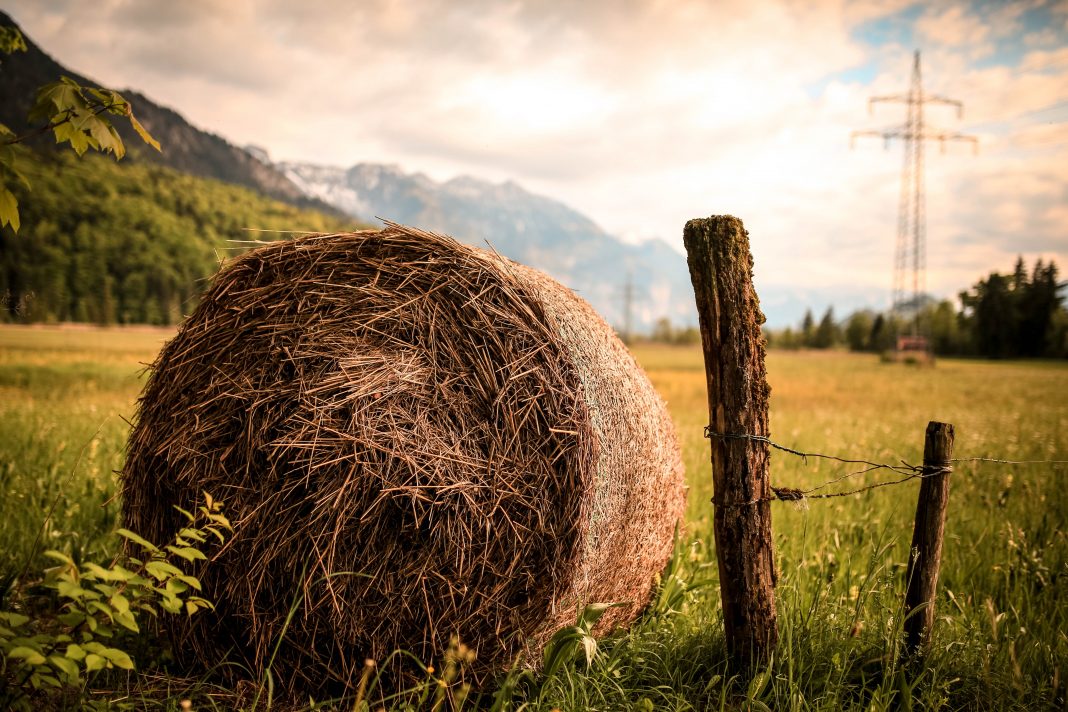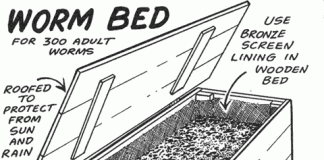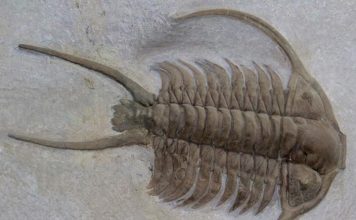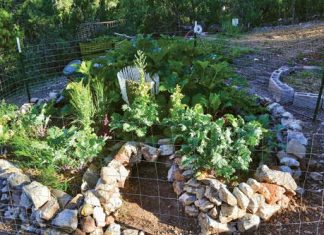 |
|
| Issue #146 • March/April, 2014 |

Most of the old fence around the garden was pretty well thrashed. Some was torn out to make way for a new septic drain field before we moved in. Inset: There was some debate among my friends over the identity of this spider. Ken said it was a female Cross Orbweaver (Araneus diadematus), but Maren claimed it was “a cross female ****ingbigholy****, fire-breathing party crashing Spider.” (Irish redacted to protect the innocent.)
Until you have a good fence, you can’t do a whole lot with your land. Although our initial plans were to get our new house fixed up before doing anything outside, it became evident that the grass and weeds had no plans to let us get settled before putting on a late summer growth spurt. I’d rather invest in a few goats than a lot of mowing equipment, but we couldn’t have goats until we had a fence. And we certainly couldn’t keep goats out of the orchard until we had a really good fence.
First we had to tear out the old fence. Metal “T” posts are notoriously difficult to pull out of the ground. My dad has an old bumper jack that he uses for the purpose. Unfortunately, the jack finally wore out before we had quite finished pulling all the posts, so the last few took considerably more effort, and even some digging. I’m glad my brothers, Jake, Robby, and Sam, and their friends, Jon and Toby, were here to do that. They worked cheap, as long as they had a constant supply of pizza.
Some of the old field fencing and most of the posts were salvageable, but a lot of wire was rusted beyond use. It took several trips to the scrap yard to get rid of it all. We’ll be able to reuse most of the wooden posts, but a few were too rotten and went to the burn pile.
Once the old fence was out of the way, I used mason twine to mark out the new fence lines. Word to the wise: don’t waste your money on the spools that come on the cheap plastic winder. They’re junk. I eventually found a stick to wind the string onto by hand.
I planned to use railroad ties for ends and corners, with metal “T” posts along straight fence lines. A 4-foot woven wire fence (field fence) would comprise most of the fencing, but 6-foot woven wire would surround the garden. (A 4-foot tall fence requires 6-foot “T” posts, and 6-foot tall fence requires 8-foot posts. The posts aren’t cheap, and longer ones are more expensive, so take this into account when planning your own fence.)
We had most of our gates on hand before we set the gate posts in concrete. A 16-foot gate is not exactly 16 feet wide. It is meant to fit into a 16-foot gap, so that measurement accounts for the hinge pins and latch, plus another inch or so of swinging clearance. Since we needed to keep livestock in and deer and dogs out, we wanted our tolerances to be very close, so we set our fence posts only after carefully measuring. If I had to do it again, I would have set every hinge post first, let the cement cure, hung the gate, and only then set the latch post.
With fences planned and gates and corners marked, it was time for the fun part: digging holes.
Rent an auger. Really. Rent an auger rather than hand dig great huge holes all over the place. We have soft, buttery dirt and we rented one anyway. The rental company delivered the skid steer with auger bit, we kept it for the day, and it took less time and cost me WAY less than paying my brothers to dig holes. Besides, I needed them to save their strength in order to hoist the old railroad ties we used as fence corners into the holes. Each tie weighs close to 200 pounds, and each one is set with about three bags of cement. That’s a lot of weight to haul around.
Once the posts were securely set into the ground and the cement had cured for several days, we hung gates, then started stretching fence. It is really important to let the cement on your posts cure thoroughly before you put up fence, otherwise the fence will pull the posts out of plumb and they will never look good.
Only the top and bottom wires of field fencing are meant to be stretched. A $40 fence stretcher from the farm store is required for this step. You just can’t get a fence taut enough by pulling on it by hand. We hooked one end of the stretcher to the hitch of the truck and the other to the fence wire, then ratcheted the stretcher until the fence was tight. Then, using fencing staples (heavy duty “U” shaped staples around 1 inch long), the fence wire was stapled to the railroad tie. We released the wire from the stretcher then repeated with the other fence wire. Once both upper and lower wires were secured, the rest of the fence can be cut and each wire stapled. If you’re at a corner, just wrap the fence around the outside of the post and continue on down the line.
You’ll notice I haven’t said anything about pounding metal posts into the ground, yet. That’s because we always stretch fence before installing the posts. This insures that the fence is really straight. My dad has been doing it this way for years, and the results are always so nice.
We banged in “T” posts every 10 feet along each fence line. Where the fence length wasn’t divisible by 10, we adjusted the distance between the posts so they would be equal, rather than end up with one odd-sized gap at the end. It only takes a few extra minutes to calculate, but the long-lasting aesthetic benefit is worth it.
It was during this step that we began discovering the nests of yellow jackets or “meat bees” as they’re sometimes called. Our yellow jackets are ground-nesters. Banging posts into the ground was loud and caused vibrations in the soil. Some of the nests were rather close to the fence line. They are aggressive and territorial. Everyone was chased and bitten on numerous occasions.
After I was bit on the butt right through my jeans, I talked to several locals and folks at the feed and hardware stores, but nobody had a good method to eradicate them. Gas was suggested, along with the aerosol cans of wasp and hornet spray. In the end, nothing really worked. The only way to avoid being bitten was to work very early in the morning, very late at night, or wait until winter, when the workers all die and the queens find a place to hibernate.
By luck, I recently discovered many of the hibernating queens overwintering inside an electrical breaker box outside and fed them all to the chickens. That should help dramatically reduce the number of nests this year.
Once all the posts were in place, we secured the fence to them with the wire clips that came with the posts. If you’re reusing older posts, you can just use lengths of 12-gauge wire. A fencing tool comes in handy at this stage, because the wire is stiff and a bit of extra leverage is helpful. Regular pliers will do in a pinch, and are more convenient for fastening the lower fence wire next to the ground. We secured the 4-foot fence in three places, and the six-foot fence in four places.
Breaking the fence
Not long after the fence was completed, we got hit with an unseasonably early winter storm which saturated the ground and knocked over our biggest apple tree. I think it was the weight of the apples, rather than the wind, that pushed it over, but in any case, it fell right on the fence, bending “T” posts and pulling one wooden post out of the ground (one of the only original posts left). It also left us with hundreds of pounds of apples to process. I ended up dehydrating lots of apples and making a bunch of my favorite applesauce, a recipe adapted from Joy of Cooking. Here it is:
Annie’s applesauce
10-12 pounds peeled, cored, sliced apples (several varieties together make the best sauce include a tart apple like Granny Smith)
2 cups apple juice (keeps the apples from burning and makes a more liquid sauce which makes filling canning jars easier)
3 Tbsp. lemon juice
3 cinnamon sticks
1/2 stick unsalted butter
I put all this in a large roasting pan and bake, covered, at 350 degrees F for 1½ hours (chunky) to 2½ hours (very smooth).
Break up or mash, then add:
1 cup honey
2 tsp. ground ginger
1½ tsp. ground mace
3 tsp. vanilla
Mix well, then fill prepared jars and process in a boiling water bath canner for 20 minutes.
We attempted to save the tree by cutting off most of the branches, then tying a rope to it and pulling it upright with a truck. We tied it to another tree nearby, then used one of the sawed off branches as a brace. It has been several months, now, and the tree is still standing. The final test will come soon when the trees start to bud out again. I hope this one has survived the trauma, because the apples it produced were delicious.
We weren’t the only ones to enjoy the unexpected bounty of apples so early in the season. Many apples and branches went to the sheep and goats, who appeared to enjoy them just as much as we did.





















